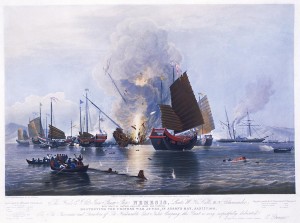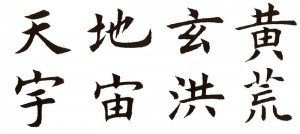By Matt Turner


- Examples from the Thousand Character Classic, made by the Wikipedia user Wjfy
Early childhood education in China can be traced well over a millennium into the past with The Thousand Character Essay, the first basic literary text in Chinese history. It was written by Zhou Xingxi over 1500 years ago and was used by Chinese children in much the same way that the alphabet song is used by western children. It is still partly in use in many regions of China. The Hundred Family Surnames is another educational document that has survived for centuries. Although it was written nearly a millennium ago, the 504 surnames it contains are still used by 90% of all Chinese (Shi 2014). A final classical text memorized by children was the The Three-Character Classic, a poem consisting of couplets of three characters that emphasized Confucian values and behavior. Children had to memorize this poem before they could learn to read or write.
Confucian values were heavily emphasized in much of Chinese early education throughout the centuries. For most of Chinese history, early education was focused on preparing children for the massive and strenuous civil service examinations. A high placement on the exam would allow one to take a job in the government and often offered an escape from poverty, as all classes could take the test. However, since only males could be given government positions, for the most part, only boys were educated, and the girls who were educated were a small minority. Studying for the exam mainly involved memorization of Confucian texts and values.
However, as the 19th century came and went, Confucianism began to fall out of favor. China suffered a series of defeats to foreign powers and was humiliated by the Unequal Treaty System. Thus, schools began to switch to a more western style of teaching, culminating with the abolishment of the civil service exam in 1905, changing early Chinese education forever.
The next few decades saw early Chinese education in a constant state of flux, with the 1911 Revolution, the Second Sino-Japanese War, and the Civil War rocking China to its very core. Even afterwards, the Cultural Revolution kept many from becoming educated and illiterate. It wasn’t until 1978 that a series of reforms helped Chinese schools to improve. In 1986, the government passed “Compulsory Education Law of the People’s Republic of China”, which sparked a flood of pro-educational reforms and policies such as the Education for All and Millenium Goals. Today compulsory education is available to 99.7% of the Chinese populace, an incredible number.
Early education continues to improve in China; it has been made a national priority and over 100 million children have been given early education of a much higher quality (Vauqhan 1993). However, great challenges remain, and China’s government must be willing to put even more work into this incredibly important issue.
For more information on Early Education in China, check out these blogs:
Early Educaiton in China: Progression of Society
Early Education in China: Effects on Higher Education
Early Education in China: Culture
Citations:
Shi, Evelyn. “Bai Jia Xing: The Hundred Surnames.” China International Travel Service. China International Travel Service, n.d. Web. 4 Apr 2014. <http://www.cits.net/china-guide/china-traditions/baijiaxing-names.html>.
Vauqhan, Joan. “Early childhood education in China.”Childhood Education. 69.4 (1993): 196. Print.
